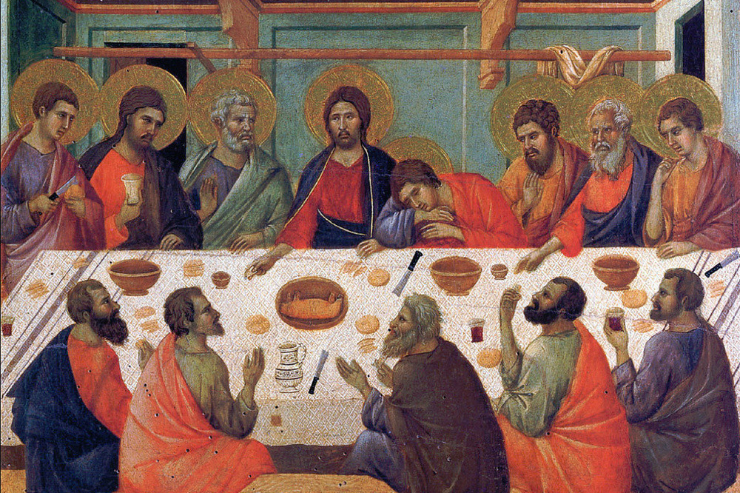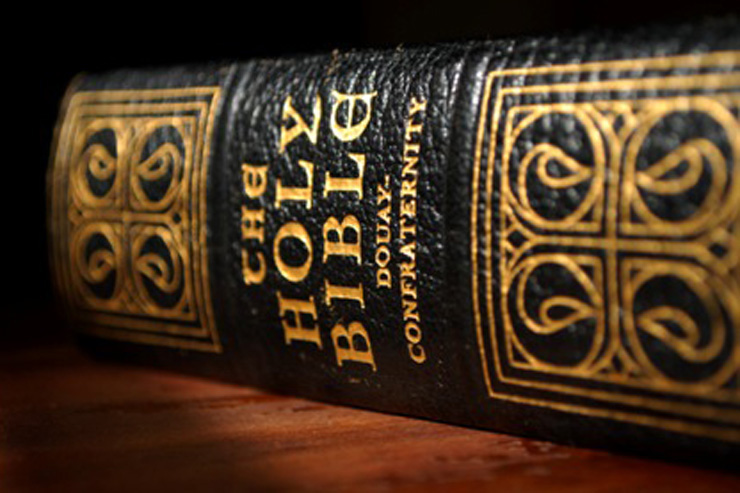
“The Last Supper” (detail) by Duccio
Holy Thursday, the night of the Last Supper aka the Lord’s Supper, the institution of the Holy Eucharist — why did Jesus do what he did and say what he said? What did he mean when he said “This is my body and this is my blood” and “Do this in Memory of Me”? And what does the Catholic Church mean by talking about transubstantiation and the body of Christ? All this is remembered & celebrated on the feast of Corpus Christi.
This post focuses on transubstantiation, transformation and the institution of the eucharist as the body of Christ. It is a reflection on the scriptures for both Holy Thursday and Corpus Christi. These come from Exodus 12:1-14, Psalm 116, I Cor 11:23-26 and John 13:1-15. Also Deuteronomy 8:2-3 & 14b-16a; Ps. 147, 1 Corinthians 10:16-17 and the Bread of Life discourse as found in John 6:51-58.
On Holy Thursday, the night before he died, the Lord Jesus made some startling changes in the ritual of the Passover meal. Instead of being content with the traditional Jewish table blessing over the bread, Jesus proclaimed “take and eat for this is my body.” Over the third cup of wine, known as the cup of blessing, he said “take and drink for this is my blood.” Then he commanded the disciples “do this in memory of me.”
HOLY THURSDAY, CORPUS CHRISTI & THE EUCHARIST
Obedient to the wishes of the savior, we remember and reenact this solemn moment in a special way each Holy Thursday and Feast of Corpus Christi, but more frequently in every Mass. Indeed the Catholic Church teaches that in the Eucharist, the communion wafer and the altar wine are transformed and really become the body and blood of Jesus Christ. Have you ever met anyone who has found this Catholic doctrine to be a bit hard to take?
If so, you shouldn’t be surprised. When Jesus spoke about eating his flesh and drinking his blood in John 6, his words met with less than an enthusiastic reception. “How can this man give us his flesh to eat? (V 52). “This is a hard saying who can listen to it?” (V60). In fact so many of his disciples abandoned him over this that Jesus had to ask the twelve if they also planned to quit. It is interesting that Jesus did not run after his disciples saying, “Don’t go – I was just speaking metaphorically!”
THE EARLY CHURCH’S UNDERSTANDING
How did the early Church interpret these challenging words of Jesus?
Here’s an interesting fact. One charge the pagan Romans lodged against the Christians was cannibalism. Why? You guessed it. People heard that this sect regularly met to eat and drink human blood. Did the early Christians say: “wait a minute, it’s only a symbol!”? Not at all.
When trying to explain the Eucharist to the Roman Emperor around 155 AD, St. Justin did not mince his words: “For we do not receive these things as common bread or common drink; but as Jesus Christ our Savior being incarnate by God’s word took flesh and blood for our salvation, so also we have been taught that the food consecrated by the word of prayer which comes from him . . . is the flesh and blood of that incarnate Jesus.”
REAL PRESENCE – TRANSUBSTANTIATION
Not many Christians questioned the real presence of Christ’s body and blood in the Eucharist till the middle ages. In trying to explain how bread and wine are changed into the body and blood of Christ, several theologians went astray and needed to be corrected by Church authority.
Then St. Thomas Aquinas came along and offered an explanation that became classic. In all change that we observe in this life, he teaches, appearances change, but deep down, the essence of a thing stays the same. Example: if, in a fit of mid-life crisis, I traded my mini-van for a Ferrari, abandoned my wife and 5 kids to be beach bum, got tanned, bleached my hair blonde, spiked it, buffed up at the gym, and took a trip to the plastic surgeon, I’d look a lot different on the surface. But for all my trouble, deep down I’d still substantially be the same ole guy as when I started.
St. Thomas said the Eucharist is the one instance of change we encounter in this world that is exactly the opposite. The appearances of bread and wine stay the same, but the very essence or substance of these realities, which can’t be viewed by a microscope, is totally transformed. What was once bread and wine are now Christ’s body and blood. A handy word was coined to describe this unique change. Transformation of the “sub-stance”, what “stands-under” the surface, came to be called “transubstantiation.”
TRANSFORMATION BY SPIRIT & WORD
What makes this happen? The power of God’s Spirit and Word. After praying for the Spirit to come (epiklesis), the priest, who stands in the place of Christ, repeats the words of the God-man: “This is my Body, This is my Blood.” Sounds to me like Genesis 1: the mighty wind (read “Spirit”) whips over the surface of the water and God’s Word resounds. “Let there be light” and there was light. It is no harder to believe in the Eucharist than to believe in Creation.
But why did Jesus arrange for this transformation of bread and wine? Because he intended another kind of transformation. The bread and wine are transformed into the Body and Blood of Christ which are, in turn, meant to transform us. Ever hear the phrase: “you are what you eat?” The Lord desires us to be transformed from a motley crew of imperfect individuals into the Body of Christ, come to full stature.
PERSONAL RELATIONSHIP WITH JESUS
Evangelical Christians speak often of an intimate, personal relationship with Jesus. But I ask you, how much more personal and intimate can you get? We receive the Lord’s body into our physical body that we may become him whom we receive!
It is this astounding gift that we remember and celebrate on the feast of Corpus Christi.
Please share this article on Facebook and other social media below.

Please help us continue our mission!
We welcome both one-time and monthly donations. A monthly subscriber giving just $10 a month will help cover the cost of operating Integrated Catholic Life for one day! Please help us bring enriching and inspiring Catholic content to readers around the world by giving today.
Thank you and may God Bless you for supporting the work of Integrated Catholic Life! Integrated Catholic Life Inc is a nonprofit public charity under Internal Revenue Code Section 501(c)(3). These contributions are tax-deductible as provided under U.S. tax laws.













